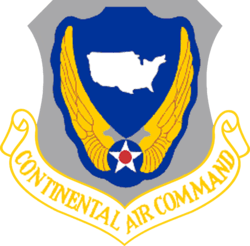74th Reconnaissance Group
The 74th Reconnaissance Group is an inactive United States Air Force unit. It was last assigned to the 91st Air Division at Stewart AFB, New York.
74th Reconnaissance Group
 | |
|---|---|
| Active | 1942–1945, 1946-1949 |
| Country | |
| Branch | |
| Role | Reconnaissance |
| Part of | Continental Air Command |
| Battle honours | American Theater of World War II |
History
The unit was first activated at Lawson Field, Georgia in February 1942 as the 74th Observation Group, shortly after the United States entered into World War II.[1] However, the group's first operational squadrons, the 11th, the newly activated 13th, and the 22d Observation Squadrons were not assigned until the following month.[2][3][4] The unit flew reconnaissance, mapping, artillery adjustment, bombing, dive bombing, and strafing missions to support ground units in training or on maneuvers.[1] It trained personnel in aerial reconnaissance, medium bombardment, and fighter techniques throughout the war until it was inactivated in November 1945.[1]
The group was reactivated in the reserves in 1946 at Stewart Field (later Stewart Air Force Base), New York. It was inactivated on 27 June 1949
Lineage
- Constituted as 74th Observation Group on 5 February 1942
- Activated on 27 February 1942
- Redesignated as 74th Reconnaissance Group on 2 April 1943
- Redesignated as 74th Tactical Reconnaissance Group on 11 August 1943
- Inactivated on 7 November 1945.
- Redesignated 74th Reconnaissance Group, allotted to the reserve, and activated, on 27 December 1946
- Inactivated on 27 June 1949.
Components
- 5th Observation Squadron (later 5th Liaison Squadron):[5] 8 Aug 1942 – 25 Jan 1943; 2 Apr 1943 – 11 August 1943 (attached 11 August 1943 – 15 Sep 1943)[6]
- 8th Tactical Reconnaissance Squadron: 15 July 1945 – 7 November 1945[7]
- 11th Observation Squadron (later 11th Reconnaissance Squadron, 11th Tactical Reconnaissance Squadron): 21 March 1942 – 7 November 1945[2]
- 13th Observation Squadron (later 13th Reconnaissance Squadron, 13th Tactical Reconnaissance Squadron): 2 March 1942 – 7 November 1945[3]
- 21st Reconnaissance Squadron: 1 October 1947 – 27 June 1949[8]
- 22d Observation Squadron (later 22d Reconnaissance Squadron, 22d Tactical Reconnaissance Squadron): 12 March 1942– 29 January 1945[4]
- 22d Reconnaissance Squadron:[9] 23 October 1947 – 27 June 1949[10]
- 31st Reconnaissance Squadron (later 33d Reconnaissance Squadron): 13 November 1947– 27 June 1949[11]
- 28th Reconnaissance Squadron (later 36th Photographic Mapping Squadron): 21 October 1943 – 29 March 1944[12]
- 101st Bombardment Photographic Squadron: 29 January 1945 – 7 November 1945[13]
Assignments
- 5th Air Support Command, 27 February 1942
- 3d Air Support Command (later III Ground Air Support Command, III Air Support Command), ca. April 1942
- IV Air Support Command, 28 December 1942
- III Reconnaissance Command (later III Tactical Air Command), ca. September 1943
- XIX Tactical Air Command, 25 October 1945 – 7 November 1945[14]
- 91st Reconnaissance Wing (later 91st Air Division), 27 December 1946 – 27 June 1949[15]
Stations
- Lawson Field, Georgia, 27 February 1942
- DeRidder Army Air Base, Louisiana, C. 14 April 1942
- Esler Field, Louisiana, c. 13 December 1942
- Desert Center Army Air Field, California, c. 28 December 1942
- Morris Field, North Carolina, September 1943
- Camp Campbell AAF, Kentucky, November 1943
- DeRidder Army Air Field, Louisiana, April 1944
- Stuttgart Army Air Field, Arkansas, February-7 November 1945
- Stewart Field, New York, 27 December 1946 – 27 June 1949.
Aircraft
- A-26, 1945
- B-18, 1942-1943
- F-6 (P-51), 1945
- F-10 (B-25), 1944-1945
- L-1, 1942-1943
- L-3, 1942-1943
- L-4, 1942-1943
- L-5, 1944-1945
- L-6, 1942-1943
- O-52, 1942-1943
- P-39, 1943
- P-40, 1943-1944
- P-43, 1942-1943
Sources[16] Equipped at various times with A-20s,
Awards
.png)
- American Theater of World War II
References
Notes
- Maurer, Maurer, ed. (1983) [1961]. Air Force Combat Units of World War II (PDF) (reprint ed.). Washington, DC: Office of Air Force History. p. 140. ISBN 0-912799-02-1.
- AFHRA Factsheet, 11th Reconnaissance Squadron Archived 4 March 2016 at the Wayback Machine (retrieved 3 Dec 2012)
- AFHRA Factsheet, 29th Attack Squadron Archived 26 February 2013 at the Wayback Machine (retrieved 3 Dec 2012)
- Maurer, Combat Squadrons, pp. 117-119
- This squadron is not related to the 5th Observation Squadron that is currently the 5th Reconnaissance Squadron
- Maurer, Maurer, ed. (1982) [1969]. Combat Squadrons of the Air Force, World War II (PDF) (reprint ed.). Washington, DC: Office of Air Force History. pp. 35–36. ISBN 0-405-12194-6.
- Maurer, Combat Squadrons, p. 49
- Maurer, Combat Squadrons, pp. 111-112
- This squadron is not related to the one previously listed. During World War II it was designated the 22d Photographic Reconnaissance Squadron
- Maurer, Combat Squadrons, p. 117
- Maurer, Combat Squadrons, pp. 184-185
- AFHRA Factsheet, 36th Intelligence Squadron Archived 26 February 2013 at the Wayback Machine (retrieved 3 Dec 2012)
- Maurer, Combat Squadrons, p. 333
- Abstract, Final History of 74th Tactical Reconnaissance Group (retrieved 4 Dec 2012)
- AFHRA Factsheet, 91st Air Division Archived 28 September 2012 at the Wayback Machine (retrieved 4 Dec 2012)
- Aircraft flown are based on the sources cited for individual squadrons. Not all squadrons flew the same aircraft while assigned to the group
Bibliography
![]()
- Maurer, Maurer, ed. (1983) [1961]. Air Force Combat Units of World War II (PDF) (reprint ed.). Washington, DC: Office of Air Force History. ISBN 0-912799-02-1.
- Maurer, Maurer, ed. (1982) [1969]. Combat Squadrons of the Air Force, World War II (PDF) (reprint ed.). Washington, DC: Office of Air Force History. ISBN 0-405-12194-6.
.svg.png)
.svg.png)